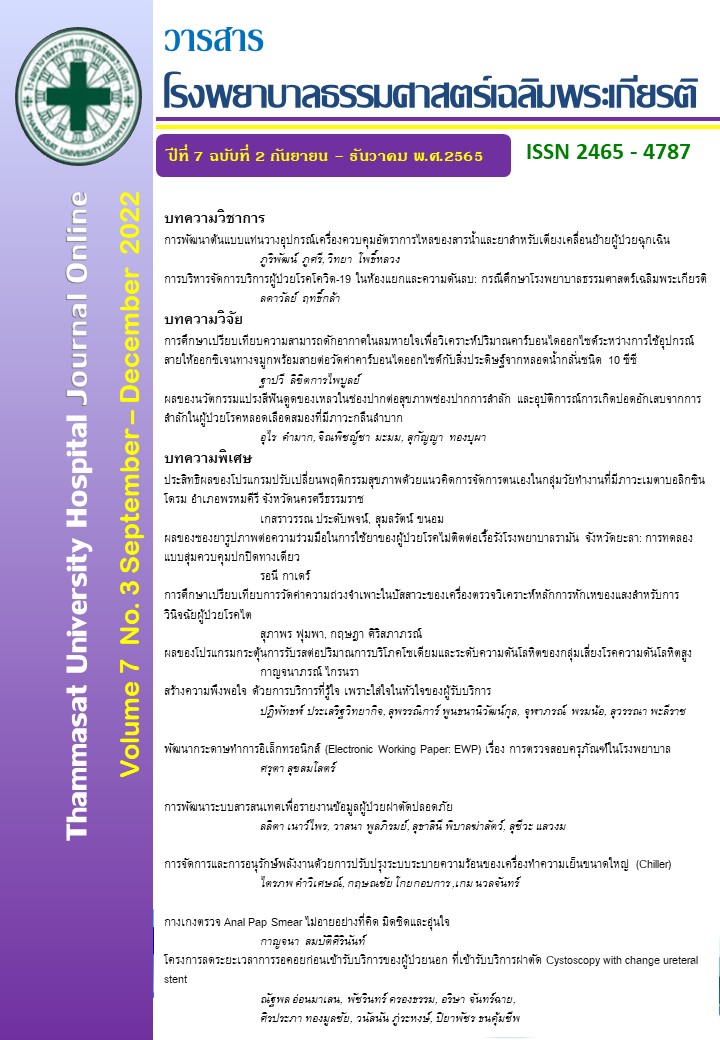A comparative study of the efficiency of the ability to trap air in the breath by analyzing the amount of carbon dioxide between using the nasal oxygen device with a carbon dioxide measurement connector and the invention from 10 cc sterile water ampule
Keywords:
End-tidal CO2, Capnography, Invention ampule sterile water 10 cc.Abstract
Background: During regional anesthesia, intravenous sedation is occasionally given to calm the patients and reduce their anxiety. The drug may reduce the level of consciousness and lead to complications from obstructive airway conditions and hypoxia. The oxygen saturation and respiration must be closely monitored. The respiratory monitoring may be performed by sampling line CO2 used in those receive oxygen cannula or oxygen mask. However, it is difficult to use due to its slippage. The strap must be fixed to the face with tape which is an obstacle to assess the patient while monitoring.
Objective: To compare the efficiency of the ability to trap air in breath, analyze the amount of carbon dioxide with EtCO2, FiO2, RR and SpO2 values between the nasal oxygen device with a carbon dioxide measurement connector and the invention from 10cc sterile water ampule.
Material and methods: The study was an experimental research. The sample consisted of 110 surgical patients undergoing regional anesthesia between December 2020 and April 2021. The instrument was an air analysis data form capnography. Records were done every 5 minutes for a total of 30 minutes.
Result: The two devices' capacity to capture air and display carbon dioxide and oxygen concentrations was as follows: 1. CO2 inhaled (FiCO2) and exhaled (EtCO2). 2. Oxygen exhaled (EtO2) and oxygen taken in (FiO2). 3. The oxygen saturation level at the fingertip. There was no significant difference between the two devices (p-value >0.05).
Conclusion: The invention from 10cc sterile water ampule can be used to monitor breathing pattern in surgical patients who have regional anesthesia with sedation.
References
จิรพรรณ โพธิ์ทอง และคณะ. วารสารวิจัยสุขภาพและการพยาบาล. การศึกษาการพัฒนาบุคลากรวิสัญญีพยาบาล ในสังกัดกระทรวงสาธารณสุข. JNHR. 2563; ปีที่ 63 (ฉบับที่ 3):259-272
Cohen L.B., Dubovsky A.N., Aisenberg J., Miller K.M. Propofol for endoscopic sedation: a protocol for safe and effective administration by the gastroenterologist. Gastrointest Endosc 2003; 58(5):725-32.
สมชาย อมรโยธิน. การระงับความรู้สึกสำหรับหัตถการส่องกล้องระบบทางเดินอาหาร พิมพ์ครั้งที่ 1. กรุงเทพฯ: ภาควิชาวิสัญญีวิทยา คณะแพทยศาสตร์ศิริราชพยาบาล มหาวิทยาลัยมหิดล; 2561
Becker, D.E., & Haas, D.A. Management of complications during moderate and deep sedation: respiratory and cardiovascular considerations. Anesth Prog [internet]. 2007 [Cited 12 May 2021]. Available from:https://www.ncbi.nlm.nih.gov/pmc/articles/PMC1893095/
Martin M.L., Lennox P.H. Sedation and analgesia in the interventional radiology department. J Vasc Interv Radiol 2003;1 4(9):1119-28.
สมชาย อมรโยธิน. การให้ยาระงับความรู้สึกทางหลอดเลือดดำ. [อินเตอร์เน็ต]. 2559. [เข้าถึงเมื่อ 12 พฤษภาคม 2564]; 16(20):2451-2457. เข้าถึงได้จาก: http://anesthai.org/public/rcat/Documents/library/1455244576Total%20intravenous%20anesthesia.pdf
Amornyotin, S., Sedative and Analgesic Drugs for Gastrointestinal Endoscopic Procedure. World J Gastroenterol. [internet]. 2021. [Cited 12 May 2021]; 16(20):2451-2457. Available from: http://www.ghrnet.org/index.php/joghr/article/view/779
Celestine Okwuone. Use of Capnography during Moderate Sedation by Non-Anesthesia Personnel in Various Clinical Settings. apsf [internet]. 2016. [Cited 12 May 2021]; 31(1):7. Available from: https://www.apsf.org/article/use-of-capnography-during-moderate-sedation-by-non-anesthesia-personnel-in-various-clinical-settings
Deitch K., Miner J., Chudnofsky C.R., Dominici P., Latta D. Does end tidal CO2 monitoring during emergency department procedural sedation and analgesia with propofol decrease the incidence of hypoxic events? A randomized, controlled trial. Ann Emerg Med 2010; 55(3):258-64.
Tobias, J.D., & Leder, M., Procedural sedation: A review of sedative agents, monitoring, and management of complications. Saudi J Anaesth [internet]. 2011. [Cited 12 May 2021]; 5(4):395-410. Available from: https://www.ncbi.nlm.nih.gov/pmc/articles/PMC3227310
Saiso K., Adnonla P., Munsil J., Apipan B., Rummasak D., Wongsirichat N. Complications associated with intravenous midazolam and fentanyl sedation in patients undergoing minor oral surgery. J Dent Anesth Pain Med 2017; 17(3):199-204.
Bellolio, M., Puls, H., Anderson, J., Gilani, W., Murad, M., Barrionuevo, P., Erwin, P., Wang, Z. and Hess, E., Incidence of adverse events in paediatric procedural sedation in the emergency department: a systematic review and meta-analysis. BMJ Open [internet]. 2021 [Cited 12 May 2021]; 6(6):1-16. Available from: https://bmjopen.bmj.com/content/6/6/e011384
Miner, J.R., & Burton, J.H., Clinical practice advisory: emergency department procedural sedation with propofol. Ann Emerg Med. [internet]. 2007 [Accessed 12 May 2021]; 50(2):182-7. Available from: https://pubmed.ncbi.nlm.nih.gov/17321006/
Lenz G, Heipertz W, Epple E. Capnometry for continuous postoperative monitoring of nonintubated, spontaneously breathing patients. J Clin Monit 1991; 7(3):245-8.
Tobias JD, Flanagan J, Wheeler TJ, Garrett JS, Burney C. Noninvasive monitoring of end-tidal CO2 via nasal cannulas in spontaneously breathing children during the perioperative period. Crit Care Med 1994; 22(11):1805-8.
Yanagidate F., Dohi S. Modified nasal cannula for simultaneous oxygen delivery and end-tidal CO2 monitoring during spontaneous breathing. Eur J Anaesthesiol 2006; 23(3):257-60.
Loughnan T, Monagle J, Copland J, Ranjan P, Chen M. A comparison of carbon dioxide monitoring and oxygenation between facemask and divided nasal cannula. Anaesth Intensive Care 2000; 28(2):151-4.
McGovern, T. Face Mask Capnography. [internet] emupdates; 2021. [Cited 12 May 2021]. Available from: https://emupdates.com/face-mask-capnography
Gaucher A, Frasca D, Mimoz O, Debaene B. Accuracy of respiratory rate monitoring by capnometry using the Capnomask® in extubated patients receiving supplemental oxygen after surgery. Br J Anaesth 2012; 108(2):316-20.
An Updated Report by the American Society of Anesthesiologists. Practice Guidelines for Sedation and Analgesia by Non-Anesthesiologists. Anesthesiology; [internet]. 2002 [Cited 12 May 2021]; 96:1004-1017. Available from:https://doi.org/10.1097/00000542-200204000-00031
Aminiahidashti H, Shafiee S, Kiasari AZ, Sazgar M. Applications of End-Tidal Carbon Dioxide (ETCO2) Monitoring in Emergency Department; a Narrative Review. Emerg (Tehran) 2018;6(1):e5.
Burki N, Albert RK. Noninvasive monitoring of arterial blood gases: a report of the ACCP section on respiratory pathophysiology. Chest. 1983;83(4):666-70.
Cox M, Kemp R, Anwar S, Athey V, Aung T, Moloney E. Non-invasive monitoring of CO2 levels in patients using NIV for AECOPD. Thorax. 2006; 61(4):363-4.
Ebert TJ, Novalija J, Uhrich TD, Barney JA. The effectiveness of oxygen delivery and reliability of carbon dioxide waveforms a crossover comparison of 4 nasal cannulae. Anesth Analg 2015; 120(2):342-8.
Downloads
Published
How to Cite
Issue
Section
License
Copyright (c) 2022 Thammasat University Hospital Journal Online

This work is licensed under a Creative Commons Attribution-NonCommercial-NoDerivatives 4.0 International License.



